Most people wouldn’t want to imagine living in an RV without air conditioning. This may not be true if you visit only colder places or mostly travel in the winters, but that’s not all that common. If you use an RV as your only home, second home or vacation indulgence when the temperatures start to warm up, then AC is a must. As a part of your travel adventure, predicting temperature and living through transitioning climates is a given.
In this article, we’re going to share details of how to choose an AC for your RV. We’ll look at some of the challenges to installing the units and tips to maintain it. We’ll review some different options available in the market and some of the best brands that we’ve researched.
At a Glance: Our Top Picks for RV Air Conditioners
- OUR TOP PICK: Dometic Brisk II
- RUNNER-UP: Coleman 08-0080
- BEST BUDGET OPTION: Frigidaire FFRA0511R1
Comparison of the Best RV Rooftop Air Conditioners
| IMAGE | PRODUCT | |
|---|---|---|
Our Top Pick  |
| View Latest Price → |
 |
| View Latest Price → |
Best Budget Option  |
| View Latest Price → |
 |
| View Latest Price → |
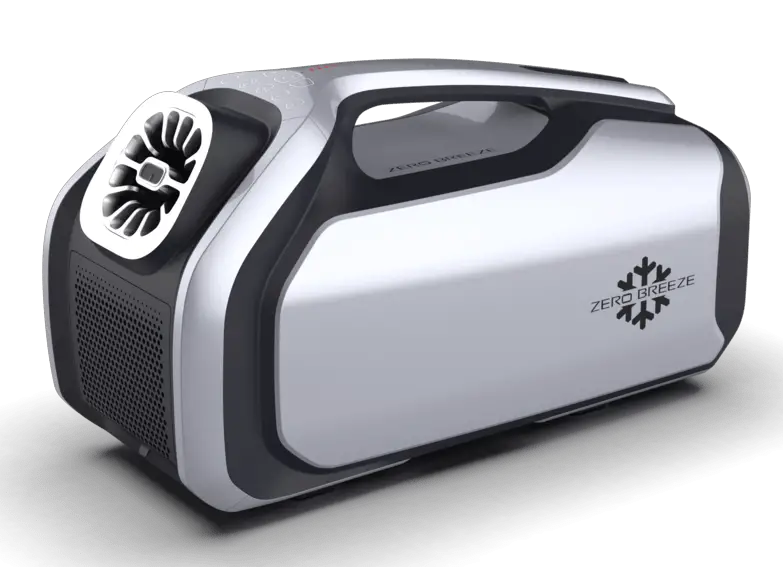 |
| View Latest Price → |
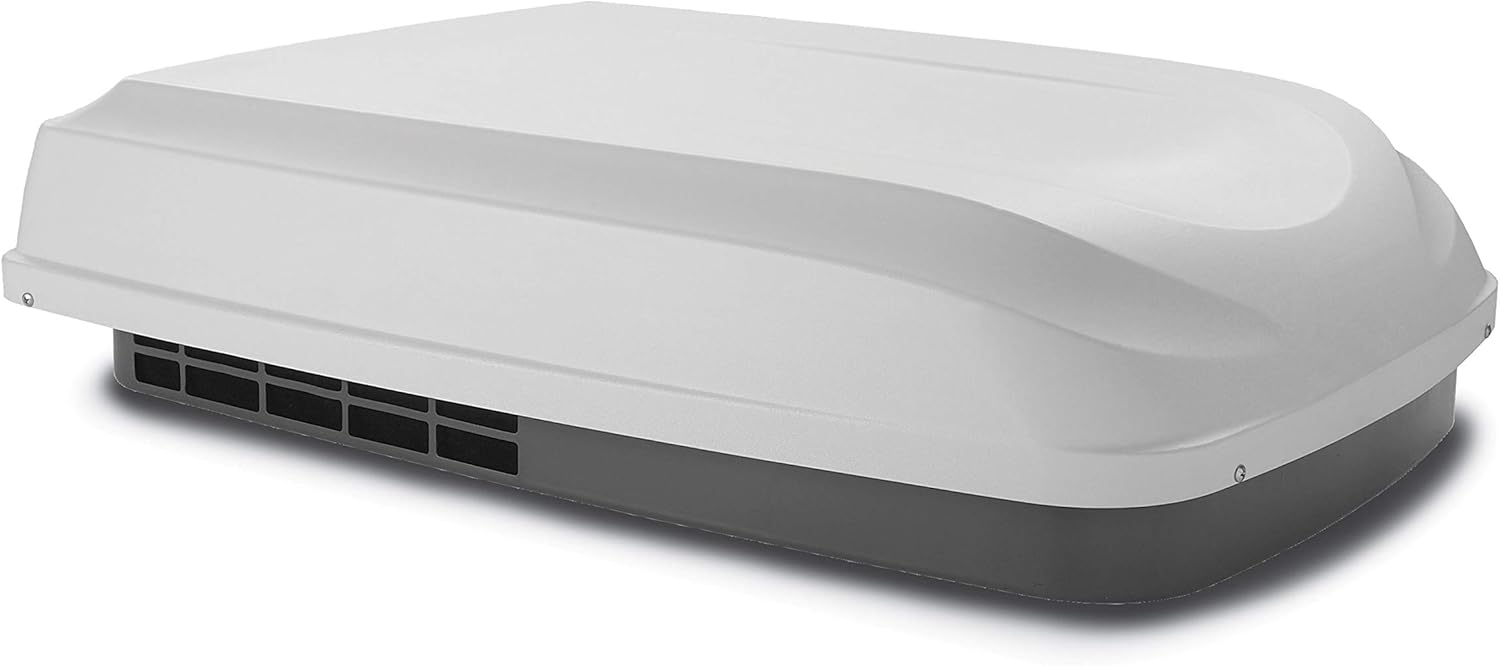 |
| View Latest Price → |
 |
| View Latest Price → |
What to Look For in Your RV AC Unit
Air conditioners for an RV have similar electrical and physical features to household units. But they also have some different features and a different degree of toughness to meet the needs of your home on wheels.
Let’s look at some of the features you’ll need to be aware of in making your choice.
BTUs
When purchasing the cooling equipment for your little space, BTUs (British Thermal Units) are perhaps the biggest factor in your decision. BTUs tells you how well an AC can cool your space. Anything beyond 13500 BTUs is what you would be looking at if you frequenting hot destinations.
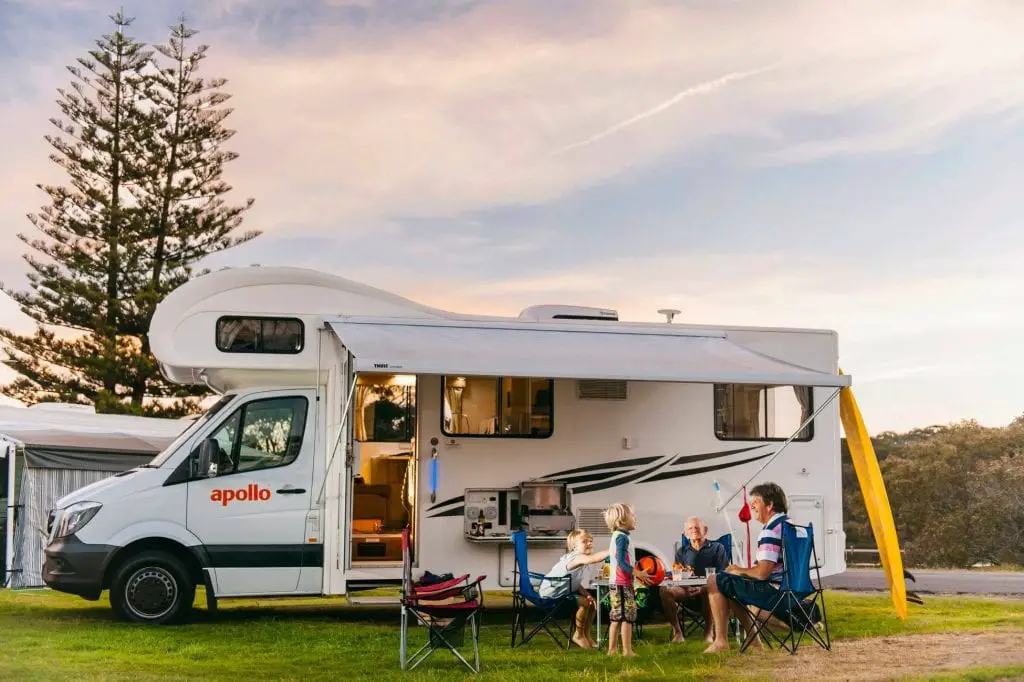
Photo credit: rvtalk.net
Remember, we’re not talking about cooling a single room, it is about cooling your entire RV. It’s a lot of space to cool, and it’s not like one large open room where the air easily enters. Also, you’re in a metal construction that’s going to hold more heat. You’re also spending a huge amount of time without shade and on hot asphalt. All those factors mean you’re going to need some extra cooling power.
A large RV can require an AC with at least 18,000 BTUs for better cooling across the mobile house.
Key Terms to Know
To help compare products in this review, we have included a few key specifications for each. Here is a quick summary of what they mean.
- BTUs: British Thermal Unit (BTU) measures energy. This refers to the energy necessary to increase the temperature of one pound of water by one degree Fahrenheit.
- Dimensions: The actual dimensions in l x w x h.
- Weight: The physical weight of the air conditioner.
- Voltage: The amount of electricity the unit uses. This determines the type of outlet it must plug into.
- Coverage Area: The amount of square footage the unit can adequately cool, determined by the manufacturer.
Reviews of the Best Rooftop RV Air Conditioners
ACs for RV are made very differently than window units. Several brands specialize in manufacturing them. You will see that most of the products reviewed below are of Dometic because they don’t just manufacture air conditioners but focus on building products for mobile living.
Best Overall:
Dometic Brisk II




PROS
CONS
The Dometic Polar White 13,500 BTU Conditioner is the ideal choice in rooftop air conditioners for RVs. It is specifically designed for this purpose, with an aerodynamic shape that will reduce your wind drag on top of your RV to as little as possible.
It is also fairly lightweight, which is awesome both in regards to making it a little easier to wrestle onto the top of your RV for installation, and for not adding a ton of additional weight to your vehicle and bumping up your required gasoline intake.
Speaking of installation, this unit is ridiculously easy to install – the only tools you will need are a screwdriver and a wrench, and most users report that the most difficult aspect of installation is actually getting the unit up to the top of your RV. It also comes with its own gasket, which makes the installation process even easier.
If you are looking for a straightforward, simple rooftop unit to effectively cool your RV, you will find it in the Dometic Polar White 13,500 BTU Conditioner.
Bottom Line
The Dometic Polar White 13,500 BTU Conditioner is the premiere in rooftop RV conditioners, with its ease of installation and aerodynamic design. The only thing you should consider is that it does not come with its own control unit.
Product Specs
BTUs:
13,500
Dimensions:
29.18 x 27.23 x 12.7"
Weight:
54.9 lbs
Power Consumption:
110V / 2800W
Runner-up:
Coleman 08-0080

PROS
CONS
This Coleman model is the highest BTU capacity air conditioner you can buy for your RV. It comes as a one-piece appliance and fits into a 14x14 hole in the roof of your vehicle.
The unit's insides are equipped with high-quality materials (gas-flux brazed joints and copper tubing) and an eco-friendly refrigerant.
The sleek design with no sharp edges helps your RV slide through the wind, while the AC keeps the inside of the vehicle cool even in the highest heat. You can order an optional heater for journeys in winter.
Bottom Line
While the unit is one of the most efficient and powerful ones on the market, many customers mention that the packaging could be better. It has no padding and can break if not shipped carefully. If it arrives in one piece, this unit is an excellent find and works as advertised.
Product Specs
BTUs:
15,000
Dimensions:
42 x 28 x 16"
Weight:
90 lbs
Power Consumption:
120V / 1800W
Best for the Money:
Frigidaire FFRA0511R1




PROS
CONS
The Frigidaire FFRA0511R1 is one of the best choices when it comes to window air conditioners for RVs. One of the most impressive qualities about this unit is that it is incredibly simple to set up and take down, and its small size makes it easy to transport. So if you are looking for a unit that you can set up inside your RV in the summer and then stow away during the winter, you will not be able to find one that is better suited for that purpose than this Frigidaire option.
Also, while it is installed in your RV’s window, we are willing to bet you will likely not even notice it is there at all – that is how little space this unit takes up. And we all know that in an RV, space is at an absolute premium, so an air conditioner that does not occupy much space is a dream come true.
Even though it is a smaller unit, do not think for a second that it has less capability than some of the larger models. This unit comes with two fan speeds, two cooling speeds, and two-way airflow directors, so it will be able to get everything done for you that a larger unit could.
Bottom Line
The Frigidaire FFRA0511R1 is an excellent RV air conditioner window unit. It is not ideal when it comes to larger spaces, but for an average-sized RV, this unit is more than effective.
Product Specs
BTUs:
5,000
Dimensions:
13.19 x 16 x 12.06"
Weight:
38.25 lbs
Power Consumption:
115V / 450W
Coverage Area:
150 sq. ft
4. Dometic B59516.XX1J0




PROS
CONS
This is one of several entries from Dometic is from their “Brisk” series. This particular model is available in 15,000 and 13,500 BTU capacities. It can be installed in a ducted or non-ducted setup.
The Brisk II has a high-performance motor and fan.
Product Specs
BTUs:
15,000
Dimensions:
29.18 x 27.23 x 12.7"
Weight:
74 lbs
Power Consumption:
115V / 2800W
5. Zero Breeze Mark 2
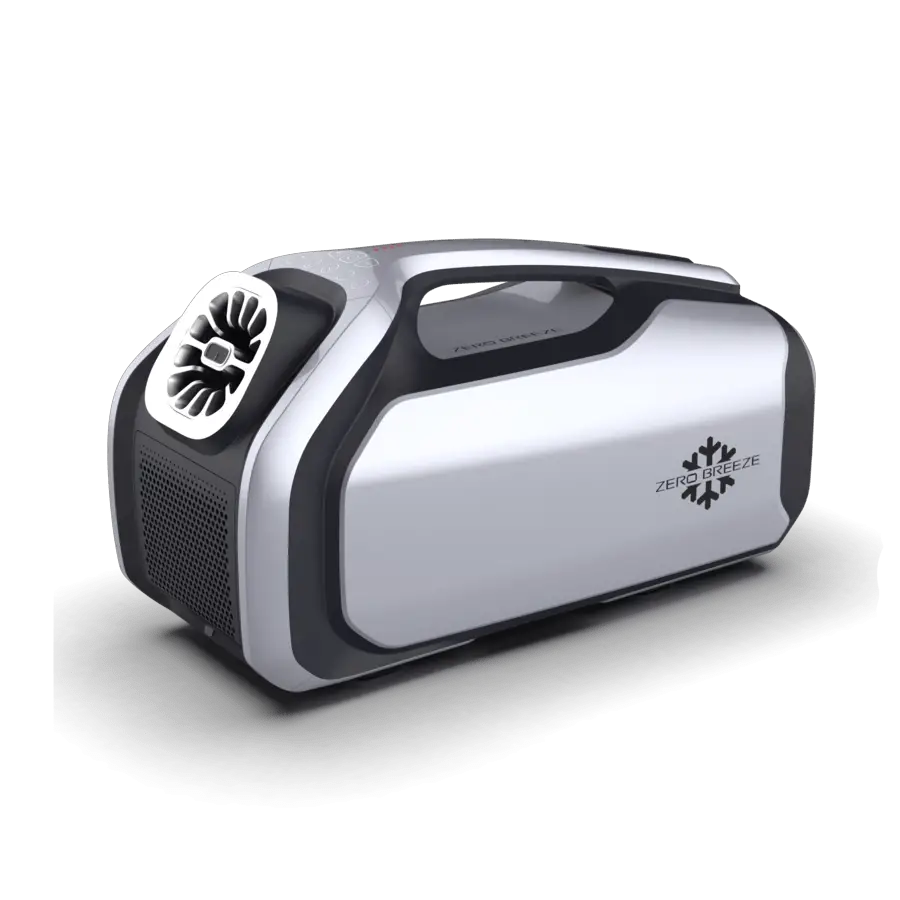



PROS
CONS
What Recent Buyers Report
Most of the users are quite happy with the product. They believe that it is the best portable air conditioner available on the market. It provides an efficient cooling solution in an easy and simple way. With a number of features and reliable cooling, it wins the heart of most buyers.
Why it Stands Out to Us
The Zero Breeze Mark 2 is probably one of the best portable air conditioners available. The way it efficiently cools your living space is simply amazing. You can easily charge it by either a car connection or solar power.
In addition, it also features the ability to combine with a battery. As a result, the unit takes significantly less space as compared to other similar devices. Amazingly, it can also operate even on the go! You can feel the cool air by holding it in your hand. The air conditioner also features a fast-charging capability with simple usage for reliable user experience.
Bottom Line
In short, the air conditioner is a great way to take care of your heating problems. What’s more interesting is its amazing cooling ability and reliable performance, wherever you go. In just a few moments, you can already feel the cool air around you!
Product Specs
BTUs:
2,300
Dimensions:
20 x 10 x 11"
Weight:
16.5 lbs
Power Consumption:
240W
Coverage Area:
25~40 sq. ft
6. Dometic 640315C Penguin II




PROS
CONS
This model again comes from Dometic - this time it’s the Penguin II. It has a sleek look and an extremely low profile at just 10 inches.
The Penguin II is a 13,500 unit that can be installed as either a ducted or non-ducted AC.
The non-ducted version comes with an (ADB) air distribution unit or control kit. Comfort Control Center II or a one-zone LCD thermostat controls the ducted version.
Product Specs
BTUs:
13,500
Dimensions:
29 x 40 x 9.5"
Weight:
99 lbs
Power Consumption:
120V / 3000W
7. Dometic 651816 CXX1C0 Penguin HP




PROS
CONS
Dometik is a leading brand for all things RV, including AC units. This one is a 15,000 BTU unit that fits into all 14-inch roof vent openings. It works with ducted and air box installations.
This is a heat pump, so the same unit is used for heating and cooling.
The gasket is included in the package. Digital Controls work with the Comfort Control Center. You will need a new CCC2 Tstat or a control board conversion in order to work this unit in a ducted system.
Product Specs
BTUs:
15,000
Dimensions:
38 x 26 x 12"
Weight:
100 lbs
Power Consumption:
110V
8. Coleman Mach




PROS
CONS
Coleman’s another product well-known for its outdoor goods and has even lent its name to the famous “Coleman stove”. Their entry in the AC realm is another low profile, 15,000 BTU air conditioner. It offers low drag and improved fuel efficiency.
This is another heat pump unit as well, so you get everything in one package for year-round comfort in your RV.
The unit has two motors which means better cooling capacity.
Product Specs
BTUs:
15,000
Dimensions:
41.1 x 28.4 x 8.25"
Weight:
93.8 lbs
Power Consumption:
120V
Best Portable RV Air Conditioner:
Honeywell MN10CESWW
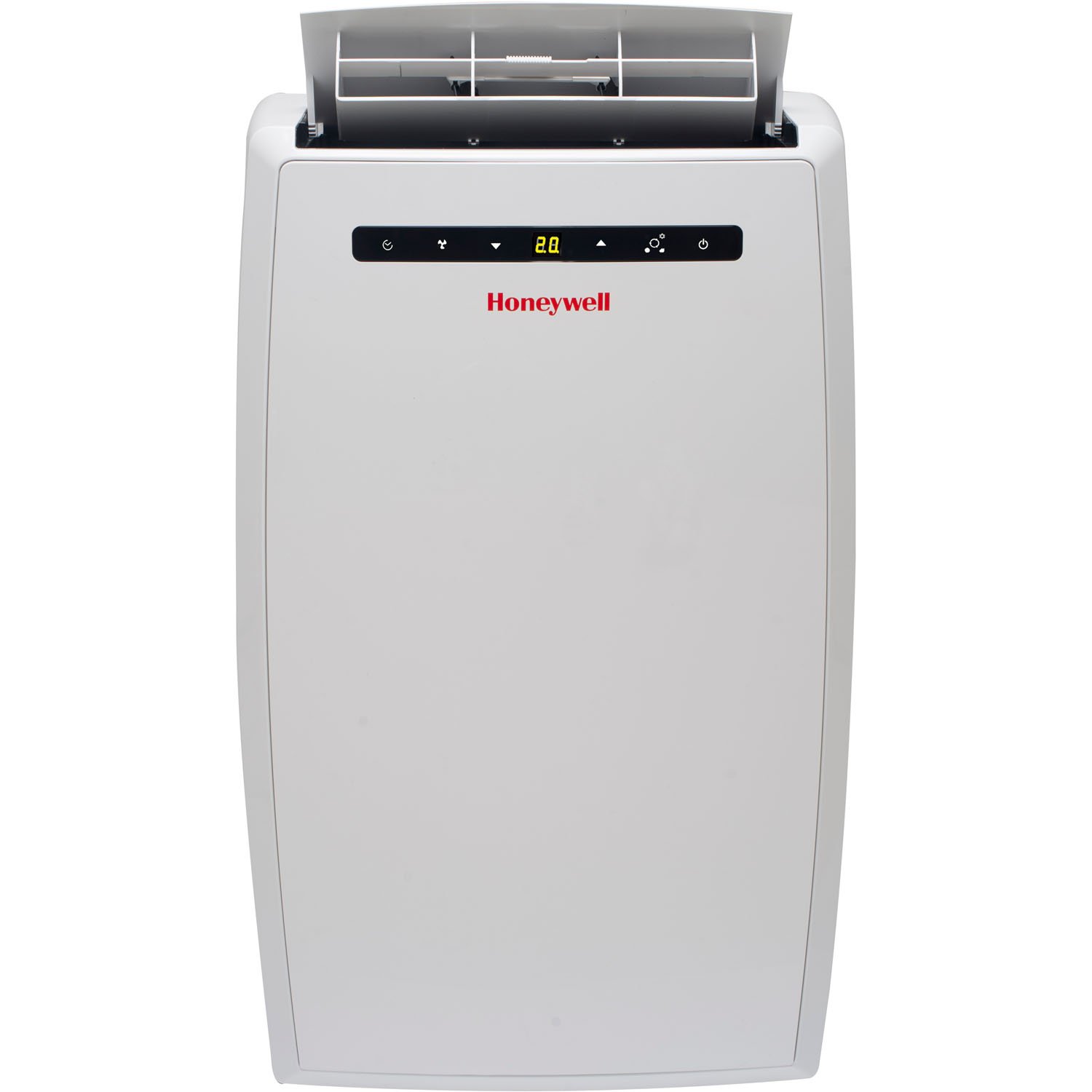



PROS
CONS
The Honeywell Portable Air Conditioner is an excellent choice for portable air conditioners that you can bring along in your RV. Whatever preconceived notions you may have had about portable air conditioners, throw them right out the window, as this little portable unit will completely blow your mind.
It is able to efficiently and effectively cool large areas without drawing a ton of power, so you will not have to worry about this unit blowing out your RV’s generator on a hot day. Users report that even when they ran this unit 24/7, the required energy to operate their RV increased only slightly. You can’t get better than that.
And even if you are running it 24/7 and mostly taking your RV through hot climates, you do not need to stress about this unit burning out on you. It is so durable it will be able to last you for years and years. And in the situation that there’s an accident and a part does break off, Honeywell is excellent when it comes to replacement and repairs. There is not much this product will not be able to do for you when it comes to RV cooling.
Bottom Line
The Honeywell MN10CESWW 10000 BTU Portable Air Conditioner is an excellent unit for your RV. It may take a minute for it to cool your RV in totality, but trust us, the wait is worth it.
Product Specs
BTUs:
10,000
Dimensions:
15.2 x 18.1 x 29.4"
Weight:
61.7 lbs
Power Consumption:
115V /1.4kW
Coverage Area:
450 sq. ft
Types of RV Air Conditioners
You may want to think about which type of AC you want for your RV. Here are the different types of RV air conditioners to choose from:
- Rooftop AC
- Vent-Free AC
- Portable AC
- Window AC
Below you will find more info about each one.
Rooftop Air Conditioners
They are the preferred option as they save space in the RV and are tucked into the roof. You find them anywhere between 5000 to 15000 BTUs. These could be ducted or non-ducted. With these, 30% of the efficiency is consumed through the vents. The unit is cooled by the air outside, which means it is influenced by the external weather.
Its installation is not easy - these ACs can weigh more than 100 pounds. It also involves connecting wires and vents. With all this, at least two people are required to complete the installation of a rooftop AC.
Vent-Free Portable AC
Vent-free portable units are also referred to as ‘swamp cooler’ because of how they handle moist air ventilation. They are relatively small in size and comes in eye-catching designs. No refrigeration process is used to cool the air. Instead, air passes through the unit and is evaporated. The dry air that’s released cools your space.
While these are energy efficient, they do take away some of your floor space - a precious commodity in an RV. You will also need to add a hose to avoid water leakages of the water drawn out of the air. The downside of this option is that it can only be used in climates with relative dry heat. They don’t work as well in extremely humid environments.




Ventless AC unit (Photo credit: rvshare.com)
Portable AC
Portable AC units for RVs are much alike the portable ones you may have in your home. They use one or two hoses to ventilate and come with adjustable frames for the window that help you keep the hoses in position.
Single-hose ACs come with the inconvenience of letting the hot air to seep inside. They are cheapest of the lot, but take up a lot of space. However, they are not very energy efficient and also add the noise of the compressor.
Window AC
Window AC units, like those used in homes, are another option. They offer great cooling capacity. Importantly, they don’t use up your floor space. They come in small sizes, as narrow as 14 inches. They’re not noisy and can be easily installed.
Factors to Consider in a Rooftop AC
We’re going to review rooftop units, so let’s take a look at some of the considerations you need to keep in mind in making your choice.
Ducted vs. Non-ducted
Non-ducted blows directly down from the ceiling unit itself, while ducted has "duct-work" just like a house. RVs with two ducts usually come with separate thermostats for each “zone”.
With ducted units you’ll face the challenge of hot air mixing with the cold air in the “gap” between zones.
Size & Shape
Your best option is going to be a unit that’s more aerodynamic. All else being equal, choose one with a low profile that is contoured well with a shape that can resist wind drag.
This helps keep your vehicle from being slowed down and also increases your fuel efficiency.
Dual Use With a Heat Pump
Though it is all about ACs here, if you want to make year-round use of your RV-AC - or travel in places or at times of year when it really cools off - then think about spending a bit more on a heat pump. More and more units use the heat pump technique, which can provide both cooling and heating to your unit.




Dometic Polar White
Brand & Replacement Units
You may be tempted to purchase everything from one place. That is, you may want to buy the AC unit from where you bought your RV. We love the “everything in one place” model, right? But be sure that your RV sales lot can provide full service for your AC as well. And it’s always a good idea to shop around as well, to be sure you get a quality project.
Installation and Maintenance
You can choose to have professionals install and maintain your unit, of course. That’s normally the safest route. But if you plan to install the unit yourself, you need to consider the weight of AC, the ease of installation and warranty provided by the manufacturer in case of failure.
You also have to factor the availability of spare parts and their price - it’s always good to think long-term in terms of an investment like this!
Read below for in depth reviews of each of the models above.
What Size AC Unit Do I Need For My RV?
RV air conditioners usually come in BTU powers between 7,000 and 15,000. The standard unit capacity for a camper that comes pre-installed with an AC is 13,500 BTU.
A few factors can help you determine the AC capacity for a given RV. First of all, if the length of the vehicle is up to 32 feet, you need one standard AC.
Second, the color of the trailer has a lot to do with thermal efficiency. Darker colors make the camper hotter under higher ambient temperature conditions.
The third is the trip location. If you're planning a trip to a desert, make sure that you rent a lighter RV and opt for a higher-power AC in it.
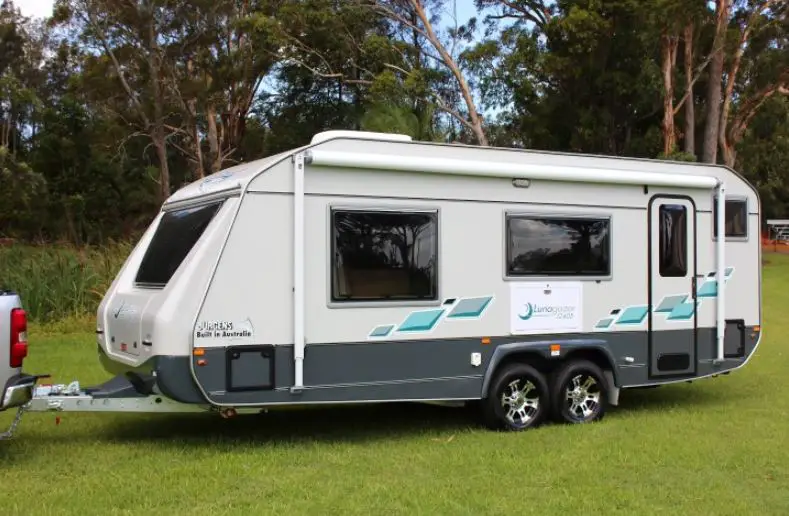


Photo credit: mozaw.com
Top RV AC Brands
The RV AC market is saturated with many quality brands and companies that specialize in vehicle air conditioning. In this section, we mention a couple of the most prominent names.
Domestic/Atwood
It has been almost a century since this brand was founded. At the beginning of the 1900s, two Swedish engineers built the world's first refrigerator and patented the product.
Decades after, in the 1950s, the large European manufacturing conglomerate Electrolux founded the leisure appliances division and called it Domestic.
Another company, Atwood, started in the dawn of the 20th century as well and entered the RV market. At the time, it was producing vehicle appliances and parts.
Closer to our times, in 2014, Domestic acquired Atwood to establish a better connection and strengthen its vehicle appliances branch. Since 2017, Atwood air conditioners, cooktops, and refrigerators are sold under the Domestic brand.



RecPro
This brand is a reseller and manufacturer of recreational vehicles, camping equipment, and appliances. It offers sleek and powerful air conditioners for trailers and RVs.
Based in Bristol, IN, this company is in the heart of RV manufacturing. One of its strengths is that it's familiar with the needs of its clients. The brand strives to make the impossible possible.
Price Points of RV Air Conditioners
There are a lot of AC choices for RVs and campers on the market. You can pick anything from a portable evaporator to a decent split system with technologically advanced functionality. Let's go through the price points and see what's the appropriate choice for your vehicle.
$150 - $1,000
This price point includes the non-specialized AC solutions, including various portable and window units with different features. The lower-end window models will have rotary controls, two fan speeds, and two cooling modes, while higher-end ones can even have smart assistant connectivity, dehumidification, and heating functionality.
$700 - $900
The specialized RV ceiling-mounted conditioners come in this price range. They typically have a cooling and dehumidification mode and can be pretty bulky for higher BTUs.
These units range from 7,000 to 13,000 BTUs. Some of them even have an additional heating function.
$1,000 - $3,000
Higher than a thousand dollars means more functionality, sleeker, more modern designs, and, what's more critical, non-ducted build.
You can install the outdoors section wherever on the car you want and not think about making the RV taller. The usual cooling capacity for these beasts ranges from 13,500 to 15,000 BTUs.
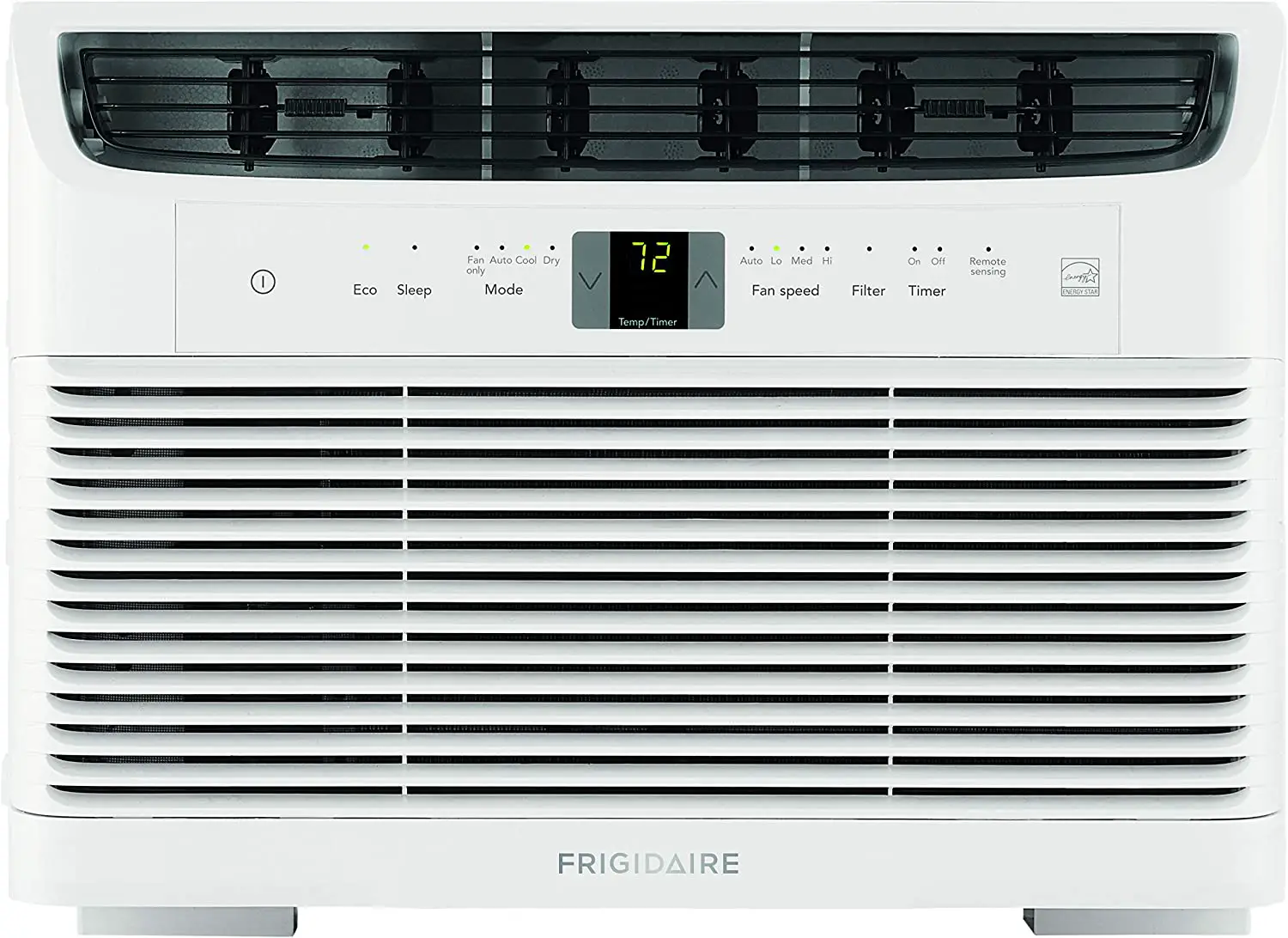


Frigidaire FFRA0511R1
How Hard is it to Install an AC Unit on an RV?
If you’re a DIYer and want to install your AC unit yourself, you’ll need some hand tools and a thorough step-by-step instruction manual that tells you how to install the AC model you purchased. If the manufacturer does not provide a manual, then find a Youtube video or any other relevant helpful article that helps you with installation.
If you have assistance, it’s definitely a lot easier.
If you’re not experienced with this type of installation or don’t have help, it’s definitely something you want to leave to the pros. Failing to install the unit properly may lead to malfunction.
Now let’s look at some of the challenges you’ll face when installing the AC unit.
Weight of the AC
A rooftop AC weighs a lot. When dealing with these units, you’ll need assistance to fix it properly in place while you fasten it down.
Leakage
Some models provide duct space for ventilation. If this is not installed, you have to deal with poor performance and constant water and air leakages.
Knowing how and where to apply sealant is another important factor to maximum your unit’s effectiveness.
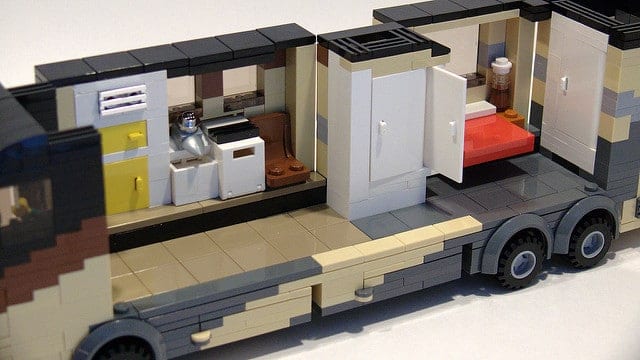



Photo credit: flickr.com
Location
Choosing the right spot to install the right type of AC matters. Rooftop ACs if not positioned properly can slow down the vehicle in windy areas.
With other types of units, location is also a huge factor. For instance, if you are using a window unit choose the window that is used least and at the same time can support an AC sleeve.
Cutting, Fitting & Mounting
This is a challenge when you need to customize your existing RV for an AC that is not supported by the vehicle. Customizing the hole in the ceiling requires utmost care to cut the hole to the right dimensions so that it can be fitted and mounted.
Tips for Maintenance
If you’ve got your A/C, then now it is time to understand the nuances of how to maintain it.
Clean the Filters
This is the most generic factor for good maintenance. Regardless of the brand or model, the filters need to be cleaned and changed from time to time. If they are left unattended, then the airflow will be reduced and the cooling ability of the AC is affected. Uncleaned filters can also increase the load on the compressor, overheating it and causing further trouble.
Clean the Evaporator
The evaporator needs to be cleaned regularly by removing the shroud and disassembling the plenum. A coil cleaner is used for this task. When you do this, you should check the condensation tubes for blockages, too.
Clean Condenser Fins
On rooftop mounts condenser fins are on the rear side of the unit. They allow the hot air to evaporate into the atmosphere. They need to be cleaned and straightened. If required use a fin guard to protect from hail storms.
Constant Inspection
Several parts should be inspected periodically. They are the upper plastic shroud for cracks and exterior deterioration.
Also take a look at your electric plug on the end of your shore cord - discoloration, pitting and swelling are bad signs and lead to loss of voltage. In that case, you can have an electrician install a new cord.
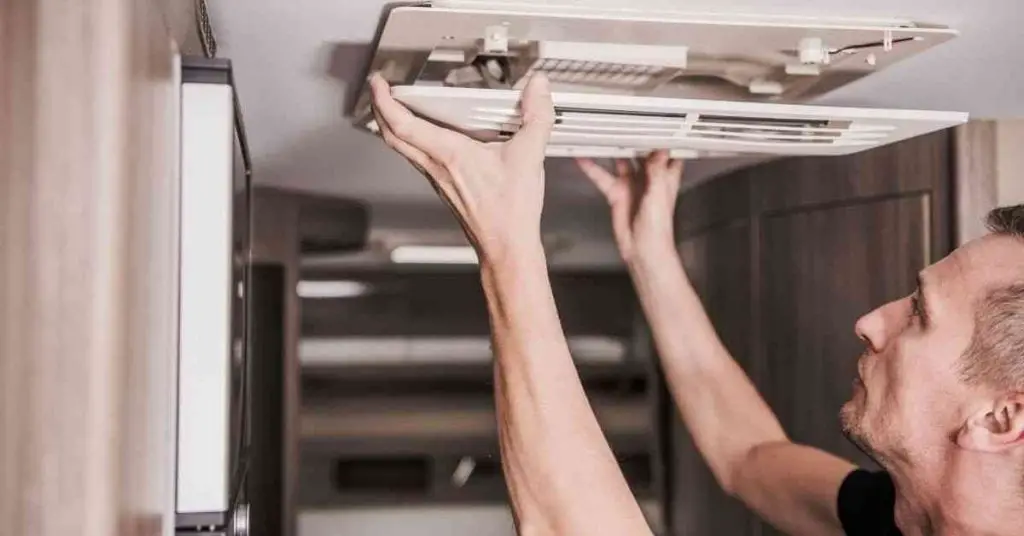


Photo credit: rvwarriors.com
Clean the Compressor
The compressor should be cleaned, but in most cases you can get by with just once every two years. Use a good spray or foaming cleaner to loosen the debris and then use a wet/dry shop vac to remove the loosened dirt and dust. But it’s a good idea to cover the vent leading down into the interior first - otherwise you could end up with gunk and grime on the floor below.
Extra Attention to Ducted Units
Occasionally remove the inside plenum and do a detailed inspection to avoid problems. Also, be sure to occasionally clean out the air vents - a vacuum hose can help suck out most of the dust and dirt that accumulates there.
Knowing the following will also help you make sure your unit works correctly:
Temperature Difference for Optimal Functioning
The temperature difference between the filter and discharge should be at least 20 degrees. Before checking this, the unit needs to run for 30 minutes. If not, have the unit checked.
Amperage
An amperage check should be done periodically by a professional. If there’s a divergence in amperage, your unit may require extensive maintenance. Otherwise, this electrical problem will continue to deteriorate the parts of the AC unit.
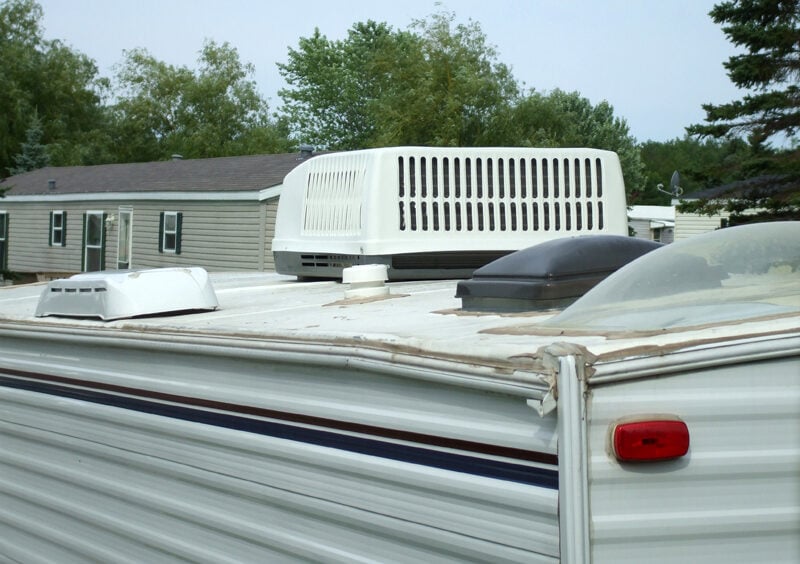


Photo credit: rvupgradestore.com
RV Heat Pump vs Air Conditioner - RV HVAC Comparison Guide
RV air conditioners and RV heat pumps are as common as the RV itself. These both work on a similar mechanism and, when needed, make living inside an RV really easy and comfortable.
Investing in good heat pumps and air conditioners is, however, the key to enjoying the facilities associated with them. But before we move on, let’s see what these are and how they compare with one another.
RV Air Conditioners
These usually exist inside RVs and work like any typical refrigerator. They do not work by cooling the room directly. Instead, they remove any and all heat from your room, thereby leaving on the cool air inside. It then disposes of this heat outside.
You can increase the efficiency of these models by closing all kinds of vents in your bedroom. This will accumulate cold air in a better way inside.
Heat Pumps
These are also important, especially because they are associated with the AC. They are built inside the AC and can be very beneficial if you use them efficiently. These heat pumps do not work when the temperature inside the RV is below 45 degrees.
Moreover, you should not attempt to run these heat pumps while plugging them into a 20A outlet. Instead, you can use an outlet that runs on higher amperes. Lastly, cranking your thermostat way up when using the heat pumps can significantly increase the propane levels in the room.
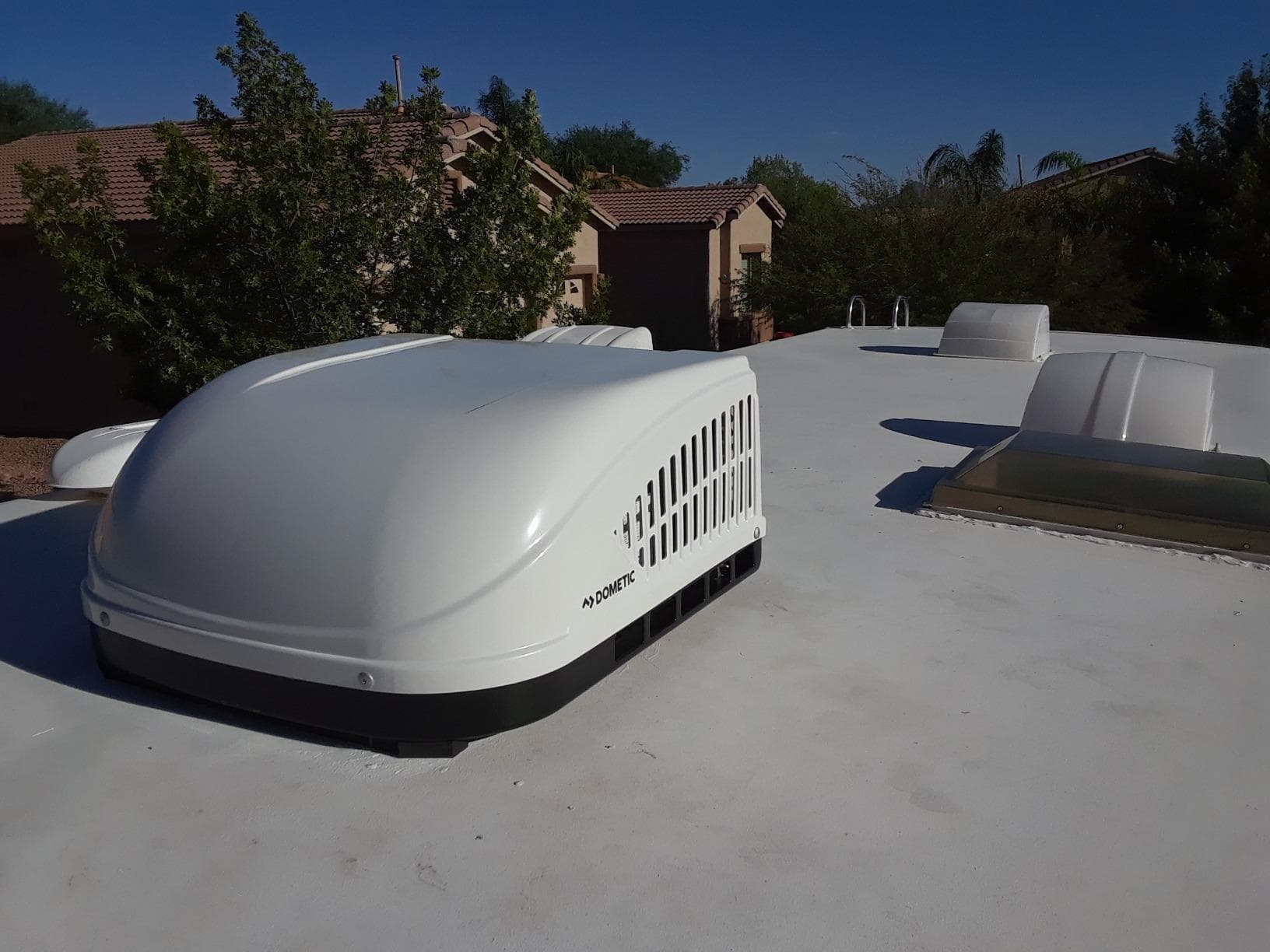



Verdict
Both these equipment are useful, but for different things. Heat pumps are usually an extra feature built into many RVs. They work by pushing the warm heat present outside inside, thereby warming the room. They are efficient but only for smaller spaces.
When you have a larger RV, these might not be sufficient to warm the whole place. On the other hand, RV air conditioners, although they serve a different purpose, are more cost-efficient and effective in the long run.
How to Clean an RV Air Conditioner
Having an RV means that you constantly need to care about better hygiene and cleanliness, and one way to do this is to keep all the equipment clean. RV air conditioners tend to make maintenance really easy. This is thanks to their efficient design and better mechanism. Here is all you need to do to clean your RV conditioner easily.
Cleaning the AC filters is the first step; it is the most obvious but also the most important one. Dirty AC filters can reduce the cooling capacity of your air conditioners to a greater degree. They also tend to decrease the efficiency of your conditioners, thus making them ineffective.
- Locate the air filters from inside your RV under the part where most air distribution takes place on the AC unit.
- These filters are made of a good washable material hence they can be placed under warm water for instant cleaning.
- You need to then place them under air to dry them completely.
- If your filters are torn and not cleaned properly, then you should try replacing them as soon as possible because they will hinder the working of your RV.
- Moreover, once you remove this filter, you will be able to see the evaporator coils. You can use a flashlight to see the inside of the coils. You can then use a vacuum lightly to remove any dirt that exists in those coils.
- This next step might be a bit difficult, but if you are comfortable enough to do it, you definitely should because it’s very effective. You simply have to go on top of your roof and clean the outside coils of your air conditioner.
- This also requires you to remove the shroud on your air conditioner. This is normally held on the inner part and is firmly attached with screws.
- Once you have done all this, you can put the filters back and enjoy cool air like never before.
Reading the steps alone might be difficult. Therefore, here’s a visual representation of the steps that were just described:
Conclusion
Although you can solve the cooling issue of your RV in various ways, buying a decent air conditioning unit is our recommended way. We hope our article has managed to set you on a smoother and cooler path for your travels.
People Also Ask
People possessing RVs and those thinking of buying one in the near future are really excited about placing a good RV air conditioner inside. This has compelled them to be quite inquisitive on the internet. To help cater to these people’s questions, here are all the answers.
Are Camper AC Units Universal?
Although they are generally the same size in terms of the mounting hole they fit in, they can be bulky or lower-profile. The latter tend to provide more cooling power and eat up more fuel. Shorter units are less powerful and cost less.
How Many Watts Does An RV Air Conditioner Use?
Depending on the cooling power, RV ACs use somewhere between 1,700 to 3,500 watts to start up and 600 to 2,000 watts to run continually.
Can I Use a Portable Air Conditioner In My RV?
Yes, you can. If your RV is large enough and the portable AC won't get in the way, you can place it in the vehicle and vent it from a window or the roof. The built-in dehumidifiers can also come in handy during your trips.
A dual-hose portable unit can provide you better venting than a single-hose one.




How Much Does it Cost to Replace an RV Air Conditioner?
Air conditioners inside RVs tend to last a great while, but that only happens when you have a good model. If you are thinking of replacing your old air conditioner, you should have a budget between $250 and $700 dollar. This is how much an average air conditioner will cost. Models that are slightly bigger may cost up to $900 too.
Can RV Air Conditioners Be Recharged?
Unlike most of your home split system, an RV air conditioner unit is not meant to be charged. Their design is unique and hence works in a completely different setting. You need to have pressure gauges to check an RV unit, and you can do this without first installing the valves of the air conditioner. However, though it’s quite rare, some air conditioners do come with a split system.
How Do You Troubleshoot an RV Air Conditioner?
An RV air conditioner, like most other products, will require troubleshooting sometimes. To do this, you simply need to follow a few simple steps. This involves replacing or removing the fan motor. The model and serial numbers on the fan motor will help find you a replacement.
Moreover, you can replace the compressor if it isn’t working. One frequent way is to simply clean the condenser and the evaporator coils.
How Long Will an RV Air Conditioner Last?
This really depends on the model and brand that you buy the air conditioner from. Most reputable brands tend to last more than non-reputable ones. However, the general myth surrounding RV conditioner, which implies that cheaper products are always bad is completely wrong. You can find good and cheap RV air conditioners that last a lifetime, too, in the market.
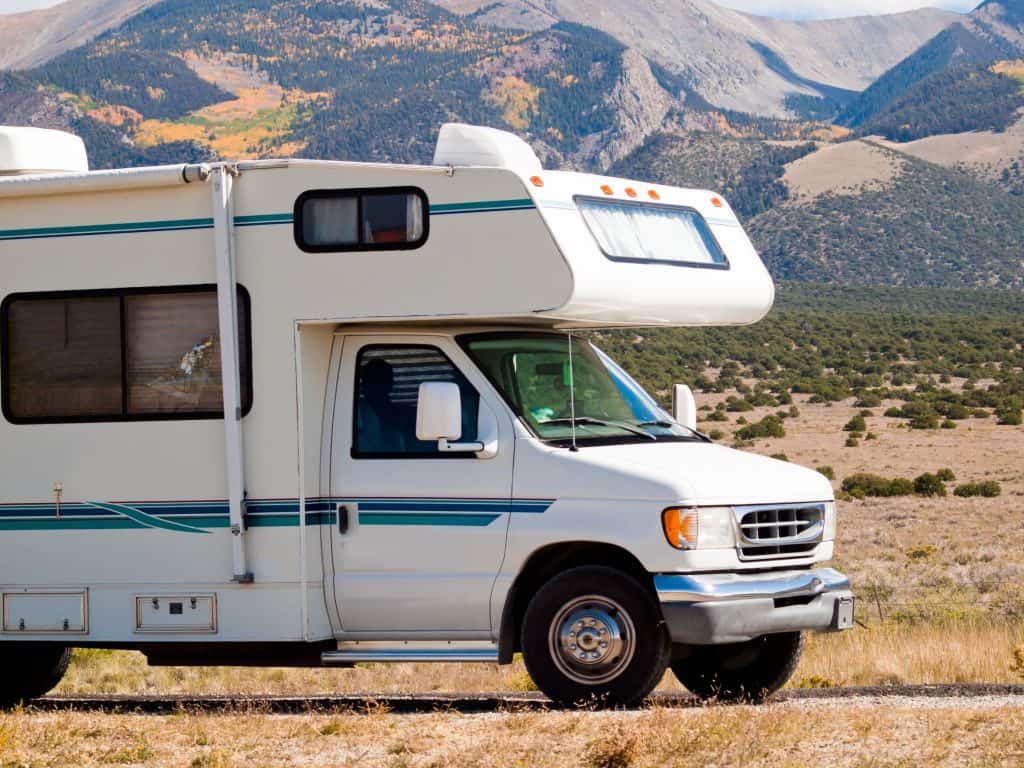


Photo credit: elliotschool.org
How Cold Should an RV Air Conditioner Get?
The main purpose of an RV air conditioner is to make the inside of the RV more comfortable. Any product that makes the RV either too cool or too hot is going to be a bad one.
A normal air conditioner should come with proper wind flow that ensures that all sides of the RV are equally cold. This prevents people from sitting in different corners to feel different levels of cold. A general rule of thumb suggests that the inside temperature should be near 20 degrees.
How Do I Keep My RV Air Conditioner From Freezing up?
If you live in a very humid area, then the chances are that your RV air conditioner is going to freeze up. This will not only hinder the proper functioning of the air conditioner but will also limit its usage. One way to prevent this is to invest in an air conditioner with good dehumidification power. You can also park your RV under shade to help avoid this.
Do RV Air Conditioners Have Filters?
Yes, they exist with almost all air conditioners and are important in the proper functioning of the product. Their main task is to filter out any dirt or harmful particles that might lead to health issues. Dirty filters, therefore, need to be cleaned as soon as possible. This can be done by removing the filters, washing them thoroughly, and then placing them back inside.
Looking to stay warm instead? Check out our RV space heater buyers guide.
